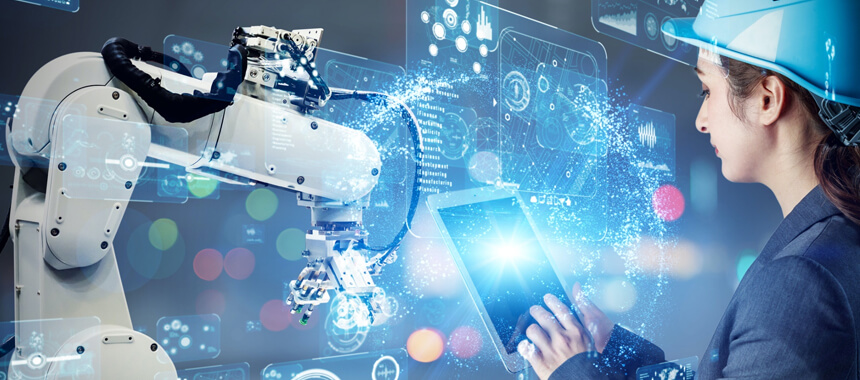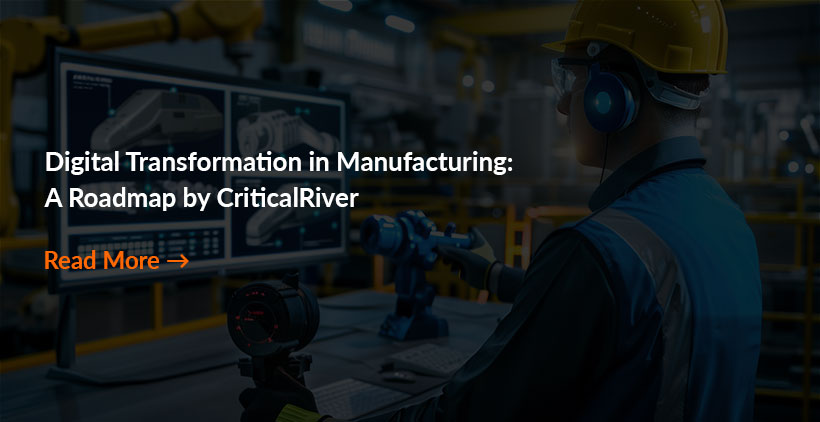Introduction
The manufacturing industry today faces stiff global competition, and its business environment is evolving quickly. It is tough to determine a market demand which was relatively stable and predictable in the past. Hence, it is vital to develop a new production system that can quickly and flexibly manage production volume changes and product life.
Technological transformations have generated numerous benefits for the world of business. New and innovative concepts like Cognitive Computing, IoT, Digitalization, and Cyber-Physical Systems (CPS) have earned pertinence across industries, particularly in manufacturing. These terms redefine Industry 4.0, the German high-tech approach by Hofmann and Rusch.
- Industry 1.0 came to Britain to offer machines into production by the fag end of the 18th century. The design of steam engines kick-started the first industrial revolution.
- Industry 2.0 or the Technological Revolution made conceivable the vast railroad networks and the telegraph that enabled the faster shift of thoughts and people.
- Industry 3.0 or the Digital Revolution came about the transformation from mechanical and analog systems to digital systems.

Below are the topics that are re-shaping the manufacturing industry:

Industry 4.0
Industry 4.0 includes a comprehensive restructuring of production methods changing analog and centralized workflows into digital and decentralized production methods.
Customer’s today need a more comprehensive range of alternatives and more personalized products. Thus, future production must be able to disrupt immediately to varied market demands.
Industry 4.0 helps businesses be ready with proof of value and a roadmap for use cases, ROI, technology, skills, budgets to expedite digital transformation. It enables industries to target the manufacturing processes to be transparent and be autonomous proactively! The worldwide market for Industry 4.0 is slated to exceed $300 billion by 2023, which is an increase of 350% in two years.

Digital Manufacturing
Digital manufacturing is when an organization leverages digital technologies to serve its manufacturing operations. It enables manufacturers to create a factory that is connected, networked, and fully integrated. It allows real-time data analytics to optimize the manufacturing process and achieve productivity gains.
Digital manufacturing allows manufacturers to reduce bottlenecks, decrease inventory, enhance quality, cut time to market, pivot swiftly to meet customer needs.
According to Deloitte, digital manufacturing has driven an average increase of 10 percent in product output, 11% in factory potential utilization, and 12% in labor potency.

Digital Customer Experience
Today, across all customer journeys, advanced digital technologies generate new opportunities for innovation and growth and create unique ways to enhance and customize the customer experience.
As manufacturers uncover new digital capabilities, some may concentrate on one aspect of the customer journey more than others. Despite the manufacturer’s focus and strategy, there are significant steps all manufacturers can take today to tackle these hurdles and get started on this path.

Artificial Intelligence
AI will wipe out almost half of the human jobs in the next 20 years. Every industry will opt to substitute humans for work with the help of AI. The adoption of AI is enabling businesses to keep inventories lean and decrease costs.

Internet of Things
We all have begun to utilize smart sensors. The IoT functionality will play a massive role in the manufacturing industry. It can trace and analyze production quotas and aggregate control rooms. IoT can also assist in creating designs for predictive support. When combined with AR and customer feedback analysis, several significant insights can help driving innovation.

Cloud
While conventional IT is very costly to procure and cumbersome to set up, moving to the cloud is more affordable and straightforward. By moving to a cloud model, excluding ongoing licensing and hardware expenses, manufacturing industries have cut collaboration costs by 40%.
Reducing hardware requirements and energy demands and shifting to the cloud reduces annual carbon emissions.

Cyber-Physical Systems
Cyber-Physical Systems are a combination of calculation, networking, and physical methods. It is the alliance of various systems of different nature whose primary objective is to manage the physical process using real-time feedback.
CPSs will play a significant role in all industry sectors and within the Industry 4.0 paradigm. CPSs will initiate new production methodologies matching the standard of tomorrow for the manufacturing industry.

Analytics
Advanced analytics refers to using statistics and other mathematical tools to business data to evaluate and develop practices. The manufacturing industry can use advanced analytics for diving into historical process data and recognizing patterns and relationships between discrete process steps and inputs.
Global manufacturers now have a wealth of real-time data and the ability to manage such complicated statistical evaluations. They are taking previously separated data sets, aggregating them, and interpreting them to disclose essential insights.

Cyber Security
Several manufacturing companies see an uptick in cyber-related events connected with the control systems used to operate industrial operations. These systems can vary from programmable logic controllers and shared control systems to secured systems and industrial IoT devices.
As smart factory initiatives increase manufacturers’ global footsteps, cyber risks will increase.
Many manufacturers’ cyber readiness is less developed than necessary to defend against current threats and vulnerabilities that digital technologies generate.

Big Data
Today, using big data is a business compulsion. It is providing solutions to long-standing business hurdles for industrial manufacturing companies worldwide. Industrial manufacturers are leveraging big data to modify their methods, their businesses, and, in most cases, whole industries.

Virtual Reality
VR helps in avoiding disruption chances linked with the use of an assembly line. Manufacturing industries can show potential threats and kill them long before they even arise using VR. It helps decrease downtime as well as servicing expenses and improves employee security.
Businesses have integrated VR into their manufacturing processes to examine production lines for possible hazards and ensure security and quality.

Augmented Reality
While artificial intelligence can streamline the complicated process of handling inventory databases, the responsibility of choosing a product from a warehouse still requires manual labor. Augmented Reality helps overcome this confusion and make this process fast and accurate.



